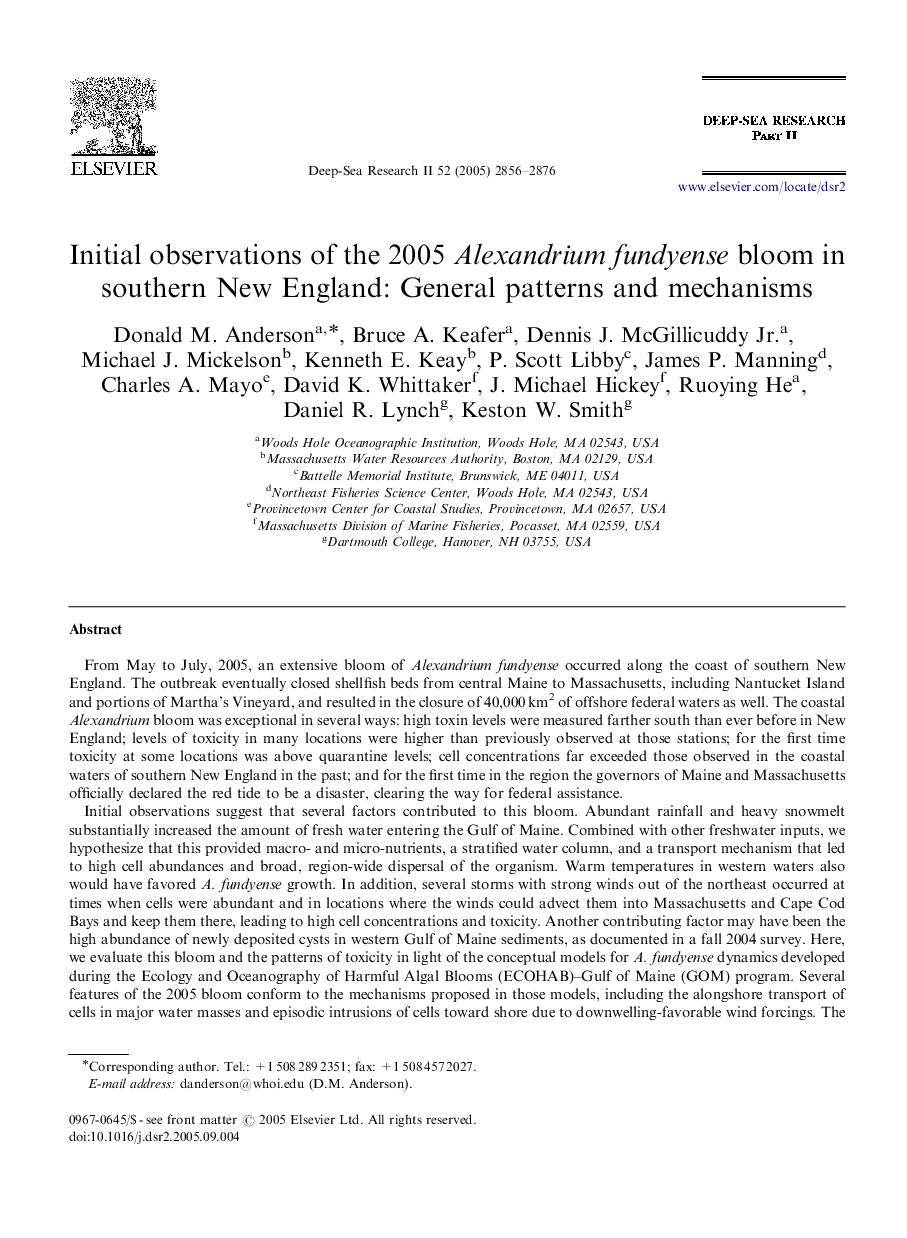| کد مقاله | کد نشریه | سال انتشار | مقاله انگلیسی | نسخه تمام متن |
|---|---|---|---|---|
| 4538599 | 1626522 | 2005 | 21 صفحه PDF | دانلود رایگان |

From May to July, 2005, an extensive bloom of Alexandrium fundyense occurred along the coast of southern New England. The outbreak eventually closed shellfish beds from central Maine to Massachusetts, including Nantucket Island and portions of Martha's Vineyard, and resulted in the closure of 40,000 km2 of offshore federal waters as well. The coastal Alexandrium bloom was exceptional in several ways: high toxin levels were measured farther south than ever before in New England; levels of toxicity in many locations were higher than previously observed at those stations; for the first time toxicity at some locations was above quarantine levels; cell concentrations far exceeded those observed in the coastal waters of southern New England in the past; and for the first time in the region the governors of Maine and Massachusetts officially declared the red tide to be a disaster, clearing the way for federal assistance.Initial observations suggest that several factors contributed to this bloom. Abundant rainfall and heavy snowmelt substantially increased the amount of fresh water entering the Gulf of Maine. Combined with other freshwater inputs, we hypothesize that this provided macro- and micro-nutrients, a stratified water column, and a transport mechanism that led to high cell abundances and broad, region-wide dispersal of the organism. Warm temperatures in western waters also would have favored A. fundyense growth. In addition, several storms with strong winds out of the northeast occurred at times when cells were abundant and in locations where the winds could advect them into Massachusetts and Cape Cod Bays and keep them there, leading to high cell concentrations and toxicity. Another contributing factor may have been the high abundance of newly deposited cysts in western Gulf of Maine sediments, as documented in a fall 2004 survey. Here, we evaluate this bloom and the patterns of toxicity in light of the conceptual models for A. fundyense dynamics developed during the Ecology and Oceanography of Harmful Algal Blooms (ECOHAB)–Gulf of Maine (GOM) program. Several features of the 2005 bloom conform to the mechanisms proposed in those models, including the alongshore transport of cells in major water masses and episodic intrusions of cells toward shore due to downwelling-favorable wind forcings. The models need to be refined and expanded, however, based on new data and observations. For example, it is now clear that cells and bloom patches can reach the outer side of Cape Cod and even Nantucket and Martha's Vineyard. Transport to the coastal waters of Rhode Island and even Connecticut/Long Island is also possible. A critical modification also may be necessary in terms of mechanisms through which A. fundyense cells occur in Massachusetts Bay. In the past, toxicity only developed when blooms were transported from the north and into the bay via the western segment of the Maine Coastal Current. Now, it is possible that the bay might serve as a source of cells through the germination of cysts deposited in those waters during the 2005 bloom. If proven in subsequent surveys, this potential for in situ bloom development could have major implications on the timing and extent of toxicity within Massachusetts Bay and southern New England waters in future years.
Journal: Deep Sea Research Part II: Topical Studies in Oceanography - Volume 52, Issues 19–21, September–October 2005, Pages 2856–2876